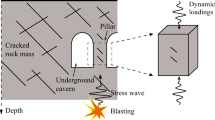Abstract
Tests to determine the complete stress–strain curve of rocks indicate whether the rocks can be classified a Class I or Class II. Class II rocks exhibits the potential for self-sustained failure in the post-peak region. The purpose of the research described in this paper was to investigate whether or not this self-sustained failure characteristic is related to the fragmentation of the rock. The aim of the research was, therefore, to determine possible relationships between fragmentation and various properties of several rocks types, including the influence of the Class II characteristic. Fragmentation of rock depends on its self-sustaining failure behaviour and the energy available in the post-peak region to shatter the rock. The correlation of static and dynamic rock properties with size of fragments resulting from compression tests demonstrate clear relationships of Class II rocks, but the same cannot be said for Class I rocks. Analyses of test results show that fragmentation increases with an increase in rock strength, and is explosive for Class II rocks. Probability density distributions were constructed to show the overall comparison of fragment sizes produced during failure of Class II and Class rocks. The calculated probability of passing at X50 and X10 sieve sizes show that Class II rocks as a group are more finely fragmented. It can therefore be concluded that, when breaking rocks under the same steady loading conditions, Class II rocks will show greater fragmentation than Class I rocks.




















Similar content being viewed by others
References
Akinbinu VA (2015) Increasing effect of metamorphism on rock properties. Int J Min Sci Technol 25:205–211
Chen ZH, Tham LG, Yeung MR, Xie H (2006) Confinement effects for damage and failure of brittle rocks. Int J Rock Mech Min Sci 43(8):1262–1269
Cook NGW (1965) The failure of rock. Int J Rock Mech Min Sci Geomech Abstr 2(4):389–403
He C, Okubo S, Nishimatsu Y (1990) A study of the Class II behaviour of rock. Rock Mech Rock Eng 23(4):261–273
International Society for Rock Mechanics Commission on Testing Methods (2007) ISRM suggested methods for rock characterization, testing and monitoring. In: Ulusay R, Hudson JA (eds) Draft ISRM suggested method for the complete stress-strain curve for intact rock in uniaxial compression. Pergamon Press Ltd published for Commission on Testing Methods, International Society for Rock Mechanics, Ankara
Okubo S, Nishimatsu Y (1985) Uniaxial compression testing using a linear combination of stress and strain as the control variable. Int J Rock Mech Min Sci Geomech Abstr 22(5):323–330
Pan PZ, Feng XT, Hudson JA (2006) Numerical simulations of Class I and Class II uniaxial compression curves using an elasto-plastic cellular automaton and a linear combination of stress and strain as the control method. Int J Rock Mech Min Sci 43(7):1109–1117
Simon R, Aubertin M,Deng D (2003) Estimation of post-peak behaviour of brittle rocks using a constitutive model for rock joints. In: Proceedings of the 56th Canadian geotechnical conference, 4th joint IAH-CNC/CGS Conference (2003 NAGS conference) (9), Winnipeg, Canada. Retrieved from http://www.enviro-geremi.polymtl.ca/pdf/articles/Simon_CGS112.pdf. Accessed May 2010
Tarasov B, Potvin Y (2013) Universal criteria for rock brittleness estimation under triaxial compression. Int J Rock Mech Min Sci 59:57–69
Yarali O, Soyer E (2011) The effect of mechanical rock properties and brittleness on drillability. Sci Res Essays 6(5):1077–1088
Author information
Authors and Affiliations
Corresponding author
Rights and permissions
About this article
Cite this article
Akinbinu, V.A. Class I and Class II Rocks: Implication of Self-sustaining Fracturing in Brittle Compression. Geotech Geol Eng 34, 877–887 (2016). https://doi.org/10.1007/s10706-016-0011-0
Received:
Accepted:
Published:
Issue Date:
DOI: https://doi.org/10.1007/s10706-016-0011-0




